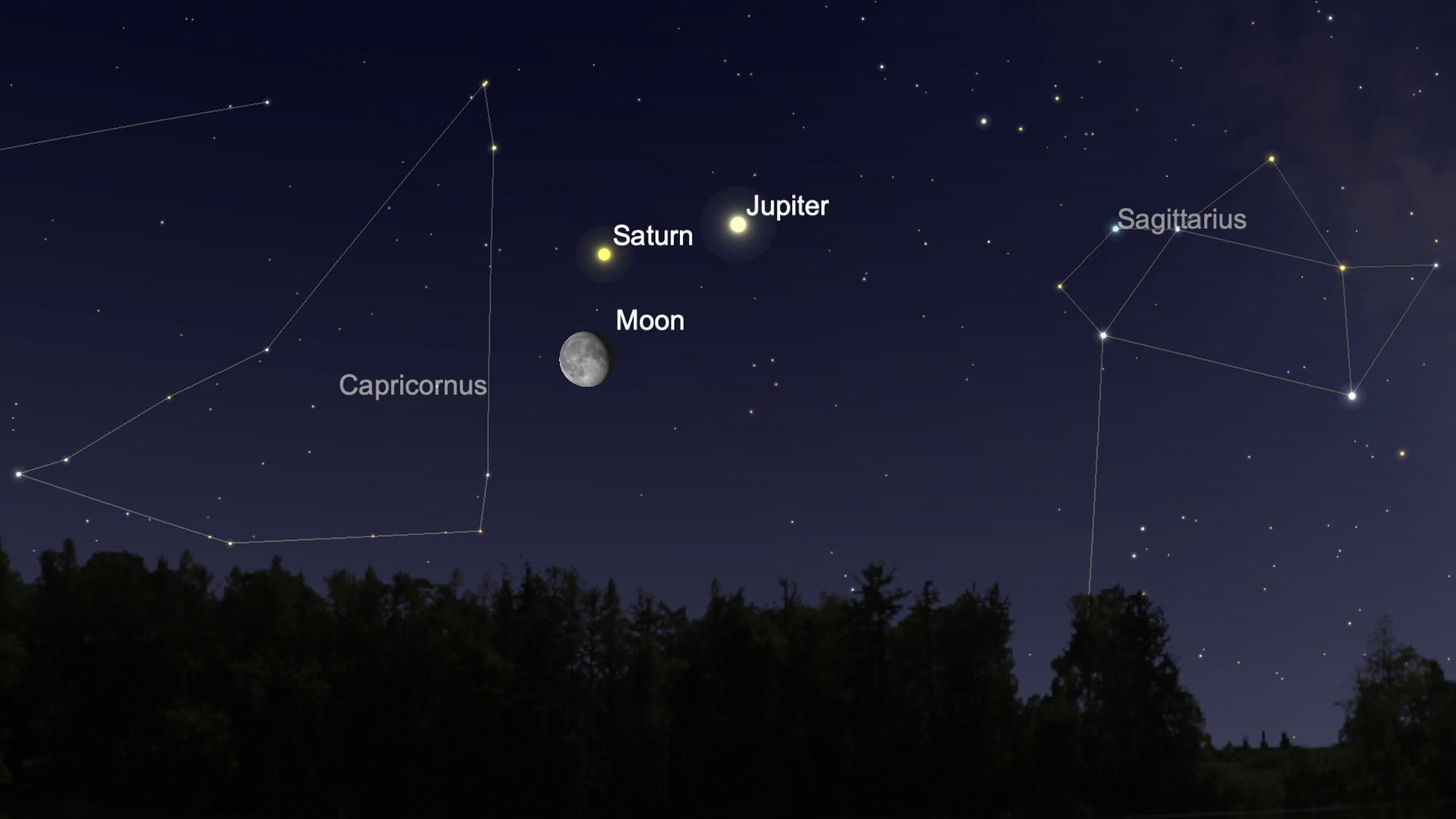Jupiter and Saturn form a triangle with the moon tonight. Here's how to see it.
For a spectacular night-sky sight you can enjoy while social distancing, look up late tonight (June 8) and early tomorrow morning to see Jupiter and Saturn form a triangle with Earth's moon.
The waning, gibbous moon was in conjunction with Jupiter — meaning they shared the same celestial longitude — today at 1:21 p.m. EDT (1721 GMT). It will swing by Saturn just nine hours later, reaching conjunction with the ringed planet at 10:12 p.m. EDT (0212 GMT on Tuesday, June 9).
The trio will rise into the evening sky just before midnight, and you can see them together all night long until they fade into the morning twilight. To find the three celestial bodies, turn to the south and look for the moon, which will guide you to the bright planets nearby. Jupiter will be to the west (right) of the moon, and Saturn will be centered above the two.
Related: Best night sky events of June 2020 (stargazing maps)
More: The best telescopes of 2020
Give your eyes about 20 minutes to get adjusted to the darkness, and if you must use a sky chart or your phone, make sure to use red light filters to keep your eyes from getting too badly affected by light (washing out your view of the night sky).
The Jupiter-moon conjunction will take place in the constellation Sagittarius. The moon will be at roughly magnitude -12.5, while Jupiter will be at about magnitude -2.6, according to In-The-Sky.org. The brightest stars visible with the naked eye are typically around magnitude 5 or 6, by comparison, so these bright objects should be easy to spot even in light-polluted areas.
If you're lucky enough to have a telescope, Jupiter and the moon will be too far apart to fit in a single field of view. But the pair will be visible in a pair of binoculars.
Breaking space news, the latest updates on rocket launches, skywatching events and more!
Later in the evening, the moon and Saturn will be in the constellation Capricornus. The moon will remain at magnitude -12.5, according to In-The-Sky.org, while Saturn will be at magnitude 0.2 — still highly visible in the night sky. Just like with the moon and Jupiter, the two celestial bodies will be too far apart for a single telescopic view. But they'll fit just fine in a pair of binoculars.
Editor's note: If you have an amazing night sky photo or video that you'd like to share for a possible story or image gallery, please contact managing editor Tariq Malik at spacephotos@space.com.
- Saturn, Mars and Jupiter align over NYC in gorgeous night-sky photos
- This is what Jupiter and Saturn look like from Mars
- When, where and how to see the planets in the 2020 night sky
Follow Elizabeth Howell on Twitter @howellspace. Follow us on Twitter @Spacedotcom and on Facebook.
OFFER: Save 45% on 'All About Space' 'How it Works' and 'All About History'!
For a limited time, you can take out a digital subscription to any of our best-selling science magazines for just $2.38 per month, or 45% off the standard price for the first three months.

Elizabeth Howell (she/her), Ph.D., was a staff writer in the spaceflight channel between 2022 and 2024 specializing in Canadian space news. She was contributing writer for Space.com for 10 years from 2012 to 2024. Elizabeth's reporting includes multiple exclusives with the White House, leading world coverage about a lost-and-found space tomato on the International Space Station, witnessing five human spaceflight launches on two continents, flying parabolic, working inside a spacesuit, and participating in a simulated Mars mission. Her latest book, "Why Am I Taller?" (ECW Press, 2022) is co-written with astronaut Dave Williams.


